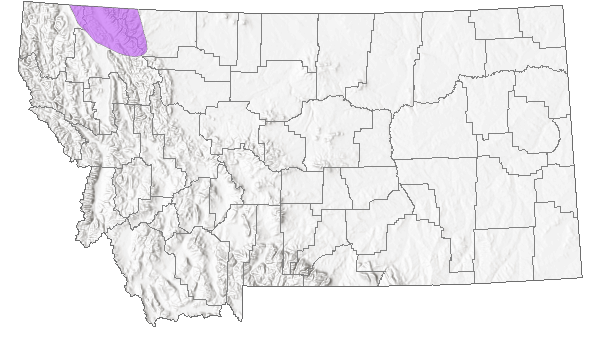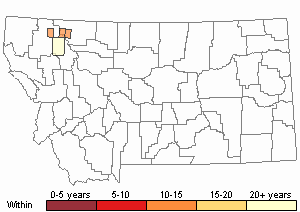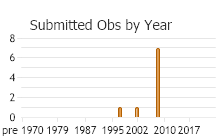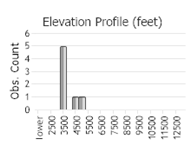View in other NatureServe Network Field Guides
NatureServe
Montana
Utah
Wyoming
Idaho
Wisconsin
British Columbia
South Carolina
Yukon
California
New York
A Mayfly - Parameletus columbiae
State Rank Reason (see State Rank above)
This mayfly is currently listed as an "S1" Species of Concern in MT due to extremely limited and/or rapidly declining population numbers, range and/or habitat, making it highly vulnerable to global extinction or extirpation in the state. Recently discovered in limited wetland locations with the Flathead River basin and Glacier Park.
General Description
This is a large, swimming, wetland and slow current mayfly with a minnow-like body and large gills along the abdomen. These could be predaceous mayflies given the modified structures of the labial palps (almost raptorial). They hatch during early spring (snow -melt) from dormant eggs laid the previous spring, and have a brief, rapid growing nymphal period until adults hatch in late-spring early summer
(Edmunds 1957).
Diagnostic Characteristics
Labial palps of the larvae with pincer-like ends; gills on all abdominal segments are heart-shaped and single, other members of this family can have double gills; abdominal segments with prominent posterolateral projections (see figure).
Species Range
Montana Range
Range Descriptions

 Native
Native
Range Comments
This species is known from Idaho, Utah, Wyoming, and British Columbia (NatureServe 2015) with new locations recently reported from Flathead County and Glacier Park wetlands in Montana (McCafferty and Newell 2007; Newell and Hossack 2009). The Idaho distribution includes four locations in Latah, Blaine, and Teton counties.
Observations in Montana Natural Heritage Program Database
Number of Observations: 9
(Click on the following maps and charts to see full sized version)
Map Help and Descriptions
Relative Density

Recency



 (Observations spanning multiple months or years are excluded from time charts)
(Observations spanning multiple months or years are excluded from time charts)
Habitat
Larvae are found in temporary ponds and fringe wetlands on the edges of lakes in association with heavy growth of broad-leaved sedges (Carex spp.). The habitat and biology of this species has been well documented (Edmunds 1957). Ironically, the species appears to be extirpated in the high-mountain Carex-wetland area of Utah where the species was studied in detail. Records from the 1960s exist for Idaho but intensive surveys recently found no specimens, and older historical records exist for British Columbia and Wyoming. The current global ranking appears warranted at this time. In Washington, it potentially could occur in Stevens Co. in Chamokane Creek because it is known from adjacent British Columbia (Meyer and McCafferty 2007). The larvae are often concentrated where a slight current exists (Edmunds 1957). In addition to lakes and ponds, this species occurs at the slack-water edges of moderately flowing rivers and streams (Jensen 1966).
Food Habits
These could be predaceous mayflies given the modified structures of the labial palps allowing them to prey on other wetland invertebrates.
Ecology
Merritt and Cummins (1996) consider larvae to be swimmers and climbers. These could be predaceous mayflies given the modified structures of the labial palps. Larvae are found in ponds and fringe wetlands on the edges of lakes in association with heavy growth of broad-leaved sedges (Carex spp.). The habitat and biology of this species has been well documented (Edmunds 1957). Ironically, the species appears to be extirpated in the high-mountain Carex-wetland area of Utah where the species was studied in detail. Records from the 1960s exist for Idaho but intensive surveys recently found no specimens, and older historical records exist for British Columbia and Wyoming. The current global ranking appears warranted at this time. The larvae are often concentrated where a slight current exists (Edmunds 1957). In addition to lakes and ponds, this species occurs at the slack-water edges of moderately flowing rivers and streams (Jensen 1966). Males were observed swarming high in the air over a small glacial stream with females flying over the water (McDunnough 1938).
Reproductive Characteristics
Eggs are deposited by females in wetlands and pools in mid-June. Eggs remain dormant during the summer and winter and “hatch within one day after the snow melts the next May.” Larvae have an extremely short development period compared to other mayfly species. Larvae crawl “out of the water one or two inches onto a Carex leaf, and the subimago emerges and flies high into a tree” (Edmunds 1957). Larvae that were wild-caught and reared in the laboratory developed into subimagoes in early to mid-June. The larval stage was less than 2 weeks (Edmunds 1957). Males were observed swarming high in the air over a small glacial stream with females flying over the water (McDunnough 1938).
Threats or Limiting Factors
Insignificant threats to the Glacier Park populations. Essentially no reduction or degradation due to threats, outside the park, wetland degradation and draining would be significant threats.
References
- Literature Cited AboveLegend:
 View Online Publication
View Online Publication Edmunds, G. F., Jr. 1957. On the life history of Parameletus columbiae McDunnough (Ephemeroptera). Utah Academy Proceedings 34: 25-26.
Edmunds, G. F., Jr. 1957. On the life history of Parameletus columbiae McDunnough (Ephemeroptera). Utah Academy Proceedings 34: 25-26. Jensen, S. L. 1966. The mayflies of Idaho (Ephemeroptera). M.S. thesis. University of Utah. 367 pp.
Jensen, S. L. 1966. The mayflies of Idaho (Ephemeroptera). M.S. thesis. University of Utah. 367 pp. McCafferty, W.P. and R.L. Newell. 2007. Insecta, Ephemeroptera: Range extensions and new state records from far western Montana, U.S.A. Check List 3:260-266.
McCafferty, W.P. and R.L. Newell. 2007. Insecta, Ephemeroptera: Range extensions and new state records from far western Montana, U.S.A. Check List 3:260-266. Merritt, R.W. and K.W. Cummins. 1996. An introduction to the aquatic insects of North America. 3rd Edition. Kendall/Hunt Publishing Company. Dubuque, Iowa. 862 pp.
Merritt, R.W. and K.W. Cummins. 1996. An introduction to the aquatic insects of North America. 3rd Edition. Kendall/Hunt Publishing Company. Dubuque, Iowa. 862 pp. Meyer, M.D. and W.P. McCafferty. 2007. Mayflies (Ephemeroptera) of the far western United States. Part I: Washington. Transactions of the American Entomological Society 133(1): 21-63.
Meyer, M.D. and W.P. McCafferty. 2007. Mayflies (Ephemeroptera) of the far western United States. Part I: Washington. Transactions of the American Entomological Society 133(1): 21-63. Newell, R. L. and B. R. Hossack. 2009. Large, wetland-associated mayflies (Ephemeroptera) of Glacier National Park, Montana. Western North American Naturalist 69(3):335-342.
Newell, R. L. and B. R. Hossack. 2009. Large, wetland-associated mayflies (Ephemeroptera) of Glacier National Park, Montana. Western North American Naturalist 69(3):335-342.
- Additional ReferencesLegend:
 View Online Publication
View Online Publication
Do you know of a citation we're missing? Wells, E.A. 1986. Alpine limnology of selected water bodies on the Beartooth Plateau, Montana, with emphasis on benthos. Ph.D. Dissertation. Bozeman, MT: Montana State University. 401 p.
Wells, E.A. 1986. Alpine limnology of selected water bodies on the Beartooth Plateau, Montana, with emphasis on benthos. Ph.D. Dissertation. Bozeman, MT: Montana State University. 401 p.
- Web Search Engines for Articles on "A Mayfly"
- Additional Sources of Information Related to "Insects"





